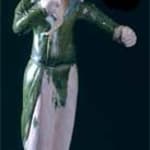T'ang Glazed Terracotta Sculpture of a Foreign Groom Featuring a Turquoise Lapel, 618 CE - 906 CE
Terracotta
17
H.697
The T’ang Dynasty was an era of unrivalled wealth and luxury. The country was successfully reunified and the borders were expanded, pushing Chinese influence into new lands. Confucianism became a...
The T’ang Dynasty was an era of unrivalled wealth and luxury. The country was successfully reunified and the borders were expanded, pushing Chinese influence into new lands. Confucianism became a semi-religious instrument of the state; yet Buddhism continued to flourish, spreading into Korea and Japan. The arts reached new levels of sophistication. Poetry and literature flourished under the enlightened rulers. The Silk Road brought fortunes into China. Precious treasures were imported on the backs of camels from far away lands and bartered for Chinese silk, medicinal herbs, and pungent spices. T’ang China was a multicultural empire where foreign merchants from across Central Asia and the Middle East settled in the urban centers, foremost among them the thriving capital of Chang’an (modern X’ian), a bustling cosmopolitan center of over two million inhabitants. Foreign traders lived next to native artisans and both thrived. New ideas and exotic artistic forms followed alongside. The T’ang Dynasty was a cultural renaissance where many of the forms and objects we now associate with China were first created. Moreover, this period represents one of the greatest cultural outpourings in human history.
Horses were among the most revered creatures in ancient China. The speed and strength of these majestic creatures was vital to the protection and expansion of the Chinese empire. While the local Mongol Pony was native to the region, larger and faster breeds were imported from Central Asia, eventually leading to the establishment of the Silk Road. This sculpture of a groom might just represent one of the foreigners who imported or cared for such horses. Dressed in an elegantly glazed green coat featuring a turquoise lapel, this groom features an expressive and emotive face that reveals his foreign origins. While his mouth, held slightly ajar, is painted red and his distinctive hat is black, it is the turquoise lapel that is most unique. The rarest of all the colored glazes, turquoise is know to appear on a mere half a dozen sculptures during the T’ang era, this splendid example being one of them.
While this groom might have accompanied a prized steed on the long and arduous journey from Central Asia to its new owner inside China, it is just as likely that this expert groom lived and resided in China, tending to the needs of a royal stable of stallions. During the T’ang Dynasty, it was not uncommon for foreigners to reside in the larger cosmopolitan centers of the empire. Clearly, this groom is no meager peasant, but a refined and respected foreigner who was memorialized in this sculpture. He holds his arms aloft in the air, as if reaching for the reigns to lead a horse. We can easily picture him lovingly combing a horse and brushing its mane. This groom is no mere worker, but a talented and respected artist who brought out the full beauty of these revered creatures.
Horses were among the most revered creatures in ancient China. The speed and strength of these majestic creatures was vital to the protection and expansion of the Chinese empire. While the local Mongol Pony was native to the region, larger and faster breeds were imported from Central Asia, eventually leading to the establishment of the Silk Road. This sculpture of a groom might just represent one of the foreigners who imported or cared for such horses. Dressed in an elegantly glazed green coat featuring a turquoise lapel, this groom features an expressive and emotive face that reveals his foreign origins. While his mouth, held slightly ajar, is painted red and his distinctive hat is black, it is the turquoise lapel that is most unique. The rarest of all the colored glazes, turquoise is know to appear on a mere half a dozen sculptures during the T’ang era, this splendid example being one of them.
While this groom might have accompanied a prized steed on the long and arduous journey from Central Asia to its new owner inside China, it is just as likely that this expert groom lived and resided in China, tending to the needs of a royal stable of stallions. During the T’ang Dynasty, it was not uncommon for foreigners to reside in the larger cosmopolitan centers of the empire. Clearly, this groom is no meager peasant, but a refined and respected foreigner who was memorialized in this sculpture. He holds his arms aloft in the air, as if reaching for the reigns to lead a horse. We can easily picture him lovingly combing a horse and brushing its mane. This groom is no mere worker, but a talented and respected artist who brought out the full beauty of these revered creatures.



